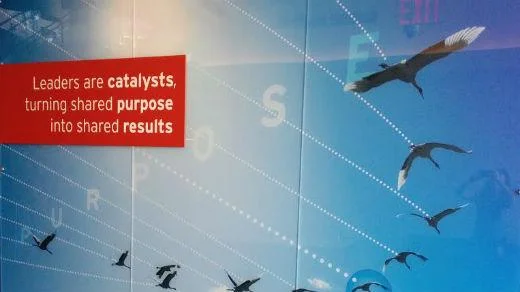Elevating Open Leaders By Getting Out Of Their Way
Your organization's leaders likely know the most effective and innovative path forward. Are you giving them the space they need to get you there?
 Jos GroenToday, we're seeing the rapid rise of agile organizations capable of quickly and effectively adapting to market new ideas with large-scale impacts. These companies tend to have something in common: they have a clear core direction and young, energetic leaders-leaders who encourage their talented employees to develop their potential.
Jos GroenToday, we're seeing the rapid rise of agile organizations capable of quickly and effectively adapting to market new ideas with large-scale impacts. These companies tend to have something in common: they have a clear core direction and young, energetic leaders-leaders who encourage their talented employees to develop their potential.
The way these organizations apply open principles to developing their internal talent-that is, how they facilitate and encourage talented employees to develop and advance in all layers of the organization-is a critical component of their sustainability and success. The organizations have achieved an important kind of "flow," through which talented employees can easily shift to the places in the organization where they can add the most value based on their talents, skills, and intrinsic motivators. Flow ensures fresh ideas and new impulses. After all, the best idea can originate anywhere in the organization-no matter where a particular employee may be located.
In this new series, I'll explore various dimensions of this open approach to organizational talent management. In this article, I explicitly focus on employees who demonstrate leadership talent. After all, we need leaders to create contexts based on open principles, leaders able to balance people and business in their organization.
The elements of success
I see five crucial elements that determine the success of businesses today:
- Talented leaders are engaged and empowered-given the space to develop, grow, and build experience under the guidance of mentors (leaders) in a safe environment. They can fail fast and learn fast.
- Their organizations know how to quickly and decisively convert new ideas into valuable products, services, or solutions.
- The dynamic between "top" and "bottom" managers and leaders in the organization is one of balance.
- People are willing to let go of deeply held beliefs, processes, and behaviors. It's brave to work openly.
- The organization has a clear core direction and strong identity based on the open principles.
All these elements of success are connected to employees' creativity and ingenuity.
 Leaders are catalysts - Image by Opensource.com
Leaders are catalysts - Image by Opensource.com
Open and safe working environment
Companies that traditionally base their services, governance, and strategic execution on hierarchy and the authority embedded in their systems, processes, and management structure rarely leave room for this kind of open talent development. In these systems, good ideas too often get "stuck" in bureaucracies, and authority to lead is primarily based on tenure and seniority, not on talent. Moreover, traditionally minded board members and management don't always have an adequate eye for management talent. So there is the first challenge! We need leaders who can have a primary eye on leadership talent. The first step to balance management and leadership at the top. Empowering the most talented and passionate-rather than the more senior-makes them uncomfortable. So leaders with potentially innovative ideas rarely get invited to participate in the "inner circle."
Fortunately, I see these organizations beginning to realize that they need to get moving before they lose their competitive edge.
They're beginning to understand that they need to provide talented employees with safe spaces for experimentation-an open and safe work environment, one in which employees can experiment with new ideas, learn from their mistakes, and find that place in the organization where they thrive.
But the truth is that there is no "right" or "wrong" choice for organizing a business. The choices an organization makes are simply the choices that determine their overall speed, strength, and agility. And more frequently, organizations are choosing open approaches to building their cultures and processes, because their talent thrives better in environments based on transparency and trust. Employees in these organizations have more perspective and are actively involved in the design and development of the organization itself. They keep their eyes and ears "open" for new ideas and approaches-so the organization benefits from empowering them.
Hybrid thinking
As I've said before: the transition from a conventional organization to a more open one is never a guaranteed success. During this transformation, you'll encounter periods in which traditional and open practices operate side by side, even mixed and shuffled. These are an organization's hybrid phase.
When your organization enters this hybrid phase, it needs to begin thinking about changing its approach to talent management. In addition to its individual transformation, it will need to balance the needs and perspectives of senior managers and leaders alongside other management layers, which are beginning to shift. In short, it must establish a new vision and strategy for the development of leadership talent.
The starting point here is to create a safe and stimulating environment where mentors and coaches support these future leaders in their growth. During this hybrid period, you will be searching for the balance between passion and performance in the organization-which means you'll need to let go of deeply rooted beliefs, processes, and behaviors. In my opinion, this means focusing on the human elements present in your organization, its leadership, and its flows of talent, without losing sight of organizational performance. This "letting go" doesn't happen quickly or immediately, like pressing a button, nor is it one that you can entirely influence. But it is an exciting and comprehensive journey that you and your organization will embark on.
And that journey begins with you. Are you ready for it?
Read the series
To be an open leader, listen to your heart
Relying on snap judgements and purely rational decisions isn't the best way to cultivate trust, empower people, and create open environments.
Optimal flow: Building open organizations where leaders can emerge
To create innovative and engaged organizations, you'll need to set the conditions for open leaders to thrive. This checklist can help.
To nurture open leaders, managers must learn to let go
Conventional managers and emerging leaders must work together to build open organizations. That requires respect, trust, and curiosity from everyone.
What Next-Generation Leaders Expect: The Choice To Work Openly
Transformation can only be successful when people opt into it. Forcing people to open up won't work.
About the author
Jos Groen is a Transformational leader and coach, passionate about the open culture and open organization approach. Jos´s ambition is for transformative organizations to be open organizations, and his mission is to give the organization back to its employees. Currently, Jos is helping organizations across the globe to succeed in their digital transformation journey thru valuable tailor-made solutions and innovative projects. This is an extensive process. In many cases, it means establishing the...More…
Attribution
This article was published in Opensource.com. It is republished by Open Health News under the terms of the Creative Commons Attribution-ShareAlike 4.0 International License (CC BY-SA 4.0). The original copy of the article can be found here.
- Tags:
- @josgroen
- agile organizations
- clear core direction
- creating contexts based on open principles
- developing internal talent
- employee creativity
- employee ingenuity
- empowering the most talented and passionate
- environments based on transparency and trust
- Jos Groen
- leaders are catalysts
- leadership talent
- management talent
- open and safe working environment
- open approach to organizational talent management
- open approaches to building cultures and processes
- open culture
- open leaders
- open organization
- open organizational culture
- open principles
- open talent development
- Opensource.com
- organization's hybrid phase
- spaces for experimentation
- talent management
- Login to post comments